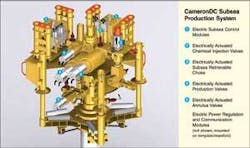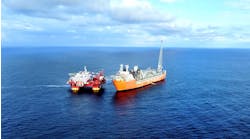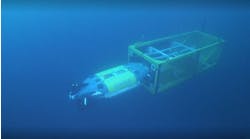Electrically operated subsea production system targets deepwater, long step-out reliability
Gene Kliewer - Technology Editor
The production scheme chosen by Total E&P Nederland BV and its partners to develop the K5F North Sea gas field consists of two subsea production installations. The news is that those installations will feature all-electric subsea Christmas trees and the accompanying electric control system from Cameron, known as CameronDC.
This new electric subsea production system is a result of Cameron addressing the concerns of operators regarding equipment reliability and functionality, and issues related to projects in deeper waters and longer distance step-out wells. Electric technology has some inherent and distinct advantages in its simplicity and in its condition monitoring potential.
As to simplicity, the control system for electric actuators does not require solenoid valves, selector valves, fluid filters, system flushing, or hydraulic fluid. The use of electric actuation makes the entire system simpler with fewer mechanical and moving parts. That benefits reliability which translates directly to operational availability.
Not requiring hydraulic fluid brings several practical and economic advantages. Although equipment suppliers have made significant strides over time, hydraulic systems still can leak. Added to this is the fact that hydraulic fluid can create an environmental issue for operators. Many newer developments are in environmentally sensitive areas and some developments have zero-tolerance emissions requirements.
Regardless of any leakage, the sheer volume of hydraulic fluid required for deepwater or extended step-out creates its own set of problems. Not only is sufficient hydraulic fluid required, but the umbilical required is more complex.
One study on that topic by Cameron used the Shtokman field in the Barents Sea as an example. Control lines in the umbilical from the subsurface equipment to the onshore surface facility could be as long as 640 km. A single control line having a diameter of 1⁄2 in. would require over 1 million liters of hydraulic fluid just to fill. While Shtokman is an extreme case, the same issue applies regardless of umbilical length. Omitting the costs of buying, storing and disposing of the hydraulic fluid improves field economics and removes the associated environmental concerns.
The alternatively used electrical umbilicals are neither new to the industry nor do they require new technology. If there is no need for an umbilical to supply chemicals for flow assurance, as an example, the umbilical becomes very small and, consequently, light. While this has many advantages for transportation and purchase cost, the umbilicals can be so light that they require weighting or trenching in to hold their position. Again, neither of these is new.
Operational advantages
Operationally, there are significant differences in response time between hydraulic and electrical actuation. A typical closing time for a hydraulic stepping choke in a conventional system can be as much as an hour, depending upon the pressure pulses and other factors. Full open to full close for an electric choke is 30 seconds.
Additionally, the CameronDC system provides sensing directly into the actuator. Conventional systems rely on pressure pulses returning to the surface to notify the operator that the actuation command has been delivered to the valve. “You do not know whether the actuator actually is functioning,” says Robert Lopez, director, Subsea Electric Systems, for Cameron. “Operators have been concerned about conventional chokes sticking. With our system, you know exactly where everything is and exactly how fast and how well it functioned. It has superior condition monitoring capability.”
“All of that information is valuable to an operator, but to us as well,” says Lopez. “It enables us to gauge the performance of our equipment over time and to make it more efficient. The monitoring capability tells the operator the status of the process in real-time. A digital signal is generated every time the valve actuates. You can see it on the computer. It draws a curve. Two years down the road, you can compare the curves and identify variations to trend performance just from comparing the valve signatures. That is a powerful tool.”
In addition to making the system more reliable, electric actuation makes redundancy possible throughout more of the system. Redundancy is part of the availability equation in that it is a backup should the primary process fail. That means the equipment still will operate even in the face of a failure. On the accompanying schematic diagram of a subsea setup, dual subsea control modules on the subsea tree, each providing a dedicated cable to every actuator, convey independent control channels to each function. The cables carry both power and communication. If one channel fails for whatever reason, the second kicks in instantaneously to maintain full operational control. That redundancy is programmed into the system. Creating a similar backup with a conventional system would be extremely complex. With the CameronDC system, redundancy is extended all the way into each actuator.
Capex considerations
The capex comparison between hydraulic and electric also illustrates the difference. With a conventional system, the project has to cater to the hydraulics. “A hydraulic power unit, which is a big, expensive piece of equipment that goes on the host facility, is required,” notes Lopez. “If it is eliminated and the cost savings from the simpler umbilical is realized, from a capex point of view, operators have validated that this is a more economical system. By doing away with equipment not needed and making the overall system simpler, the capex picture becomes very compelling.”
The same is true for opex. The through-life cost when the operator sees higher reliability and higher availability of the equipment also favors electrical.
Total’s studies before settling on a system for K5F shows that it is not only the deepwater or long step-out projects that might benefit from electrical production systems. Total was doing a full field development, not a single well. “We are not talking about a very long distance step-out,” says Lopez. “At about 20 km (step-out) and in 100 ft of water, Total conducted the same economic evaluation comparing CameronDC against conventional hydraulics. It was the higher reliability/availability that drove them toward the CameronDC system.”
The DC choice
The use of DC for long-distance power transmission has been established. There already are many DC cables subsea transmitting megawatts of power. The AC electricity is converted to DC because DC is more economical and more efficient. “The DC decision was not a hard one,” says Lopez. “The aim is to be able to control fields over long distances. For that, DC is the natural fit.” The power transmission over distance is a straight-forward calculation. “Just know how much power is required at the subsea facility and at what distance, compute the loss through the cable, and you have it. The limitation comes not from the power delivery but from the communication system as signal attenuates as you go further out.”
There is a solution for that, too: fiber optics. “That technology has come a long way,” says Lopez. “Fiber optic technology has the capacity to transmit a lot of data at high rates over very long distances. A 600-km step-out is no longer a challenge from a communications standpoint, and certainly not from a power delivery standpoint. We can provide the fiber optic capability with our system.”
While not only taking some equipment off the production facility, the CameronDC system does not require added power generation, notes Edward Will, VP, marketing, Drilling and Production Systems for Cameron. “This is not a very high power system. Rather, it is a low voltage system and is well within the capabilities of existing host systems to power.”
Move toward e-fields
The use of electricity also sets the system up for future applications such as subsea processing and “smart” wells.
“Response time, condition monitoring, accurate information...those important characteristics necessary for subsea processing exist with the CameronDC system,” says Lopez. “So it is the next step, the necessary step, to get to the ultimate aim of operators -- smart wells and e-fields. With the electric system, you can have lots of information, lots of monitoring capability, the ability to acquire information real-time, and tell exactly where everything is, how well it is functioning, and accurately monitor its performance.”
“The ability to use electrical power subsea is going to pick up pace very quickly,” adds Will. “We understand that and we are ready for it. I think this technology will be an enhancer to that pace of change. It is almost a geometric progression. You get the first one, then the first two, then you get four. The aircraft industry faced the same situation. Now we have civilian and military planes operating partially or entirely with electrical actuation, and the latest aircraft are done all-electric.”




